Red Cedar River Bird and Game Farm
Mute Swan Page

You may click on any image on this page to
view a larger version of the same picture.

More pictures available below the text
section.

Mute Swans (cygnus olor) are a very large and
beautiful bird. The male is known as a cob and the
female a pen. The young are called cygnets. The
cob and pen are similar in appearance. Their adult plumage is
entirely white. A triangular black area in front of the eyes
extends to a black fleshy knob over the nostrils. Generally males
have a larger knob than females which is most evident during the
breeding season. The area around the nostrils and tip of beak are
also black. The bill is bright red-orange fading to pink in non
breeding birds. Legs and feet of the Royal Mute Swan are black to
blackish gray. Eyes are hazel. Adult weight is from 25 to 30 lbs.
with some laying females being heavier. Mute swans often breed
their third year with a clutch of 4 t0 8 eggs which have an
incubation period of 35 to 37 days. Newly hatched cygnets have
overall pale gray upperparts and white underparts. The bill is
black and the feet and legs are pale gray.
There are no distinct subspecies recognized
(this is being disputed by some people) but a color variation
known as the Polish Mute Swan does occur. This bird differs in
its pale blue gray to pinkish legs (rather than black) on the
females. The down of the female cygnets and juveniles is dirty
white instead of pale gray. A sex linked recessive inheritance
causes the males of the Polish to have the normal or Royal Mute
juvenile appearance with dark gray legs.
In captivity, this species is readily maintained
on mixed grains, duck pellets, or a poultry feed. Green feed
daily, either as grazing or supplemented leafy vegetables or lawn
clippings should be considered. They will pick at a good quality
leafy alfalfa hay. A pond or swimming water area must be
available to them. The absolute minimum would be a few hundred
feet of surface area with a depth of about 3 feet. In the case of
Mute Swans the larger the water area the better. Mute Swans spend
the majority of their time in the water and a larger water body
is much easier to maintain. Minimal water areas need to be
drained and cleaned regularly. Larger natural ponds should not
require maintenance if they are not over crowded with birds.
The possession and propagation of Mute Swans
requires a captive wildlife permit in some states. Check with
your local wildlife authorities about permit requirements before
you decide to purchase Mute swans.

The picture gallery below contains several
pictures of our Mute Swans. You may click on any picture to view
a larger image of the same picture.

Some of our adult Mute Swans
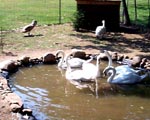
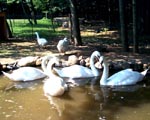
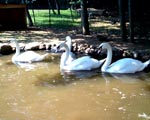
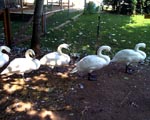
A few Mute swan cygnets. Some of these are
Royal mute and some are of the Polish variety. Explanations are
available on the larger image pages.
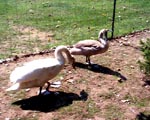

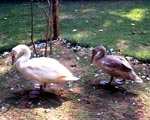

Thank you for visiting our Mute Swan page, we
hope you enjoyed your visit.
 Persons have visited this page since Sept. 9 2000.
Persons have visited this page since Sept. 9 2000.

To view our home page click the link below:
![]()
![]()
![]()
![]()
Persons have visited this page since Sept. 9 2000.
![]()